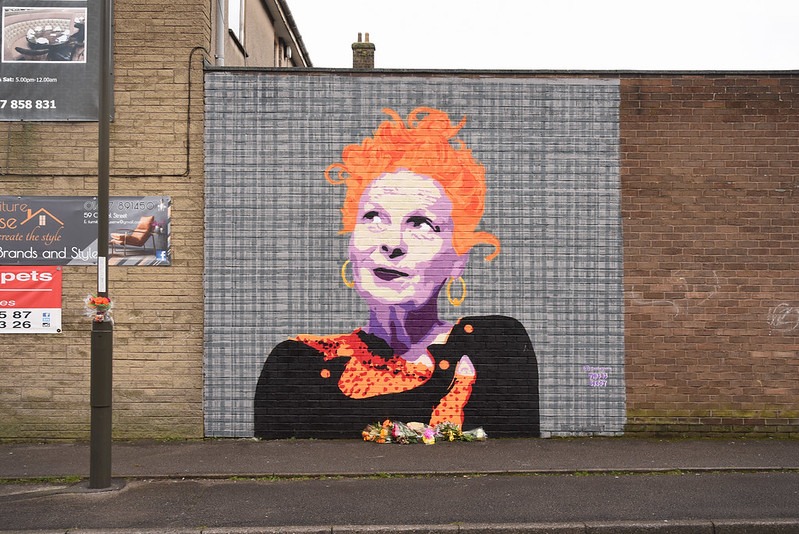My favourite designer: Vivienne Westwood
Born in a village in Derbyshire, and known for her influence on new-wave and punk fashion, Vivienne Westwood exists as one of the most well-known British designers. Although known to many as ‘the high priestess of punk fashion’, many of us Gen Zs will be familiar with Westwood from her corset designs. These iconic designs date back to her Fall Collection of 1990, recently making a comeback amidst the popularity of 90s vintage style. These incorporate François Boucher’s 18th century painting Daphnis and Chloe on a whole range of garments, which the designer brought back for her Autumn/Winter collection in 2021, in what would be one of her final collections.
So, what led her to become the successful designer she is now known to be? After leaving the Harrow Art School (now the University of Westminster), after just one term, she reportedly said: “I didn’t know how a working-class girl like me could possibly make a living in the art world.”
The question of working-class creatives in the fashion world, and artists in general, is still a prevalent topic today, with fewer and fewer individuals able to thrive in the fashion industry. In Westwood’s case, after dropping out, she trained as a primary school teacher and designed and sold jewellery in her free time, eventually earning enough to make a living from this by the 1970s.
In 1974, she and her husband Malcolm McLaren (manager of the Sex Pistols) founded the boutique SEX (previously with the names ‘Paradise Garage’, ‘let it rock’ and ‘too fast to live, too young to die’), at 430 King’s Road in Chelsea. The attire sold was inspired by sado-masochistic and fetish wear, providing staples for punk fashion. This included spikes on stilettos, unravelling mohair jumpers, and graphic tees with political messages.
Reflecting on Westwood’s designs, what is striking is the contrast she presents whether through parody or inversion.
Despite being a fan of the music from this era, what got me interested in the fashion of this era was being part of a film project a couple of years ago, with punk culture at the heart of it. There is a certain memory that has stuck with me: the costume designer hacking away at a black crop top to create uneven, jagged holes, with half of the material left, that she then secured back together with safety pins to reveal an edgy DIY creation.
So, naturally, I did some research into the clothing at the time, which led me to SEX and Westwood. The shop was later named ‘Seditionaries: Clothes for Heroes’, with items bought by members of the Sex Pistols, to further enhance their anarchist ideals with its atypical clothing. Viv Albertine, the guitarist of punk band The Slits, wrote in her memoir: “Vivienne and Malcolm use clothes to shock, irritate, and provoke a reaction but also to inspire change.” An example of her aim to shock was Westwood satirising Margaret Thatcher on the cover of Tatler in April 1989, the words ‘this woman was once a punk’ on the cover, a reference to the protests of the youth-led movement.
Reflecting on Westwood’s designs, what is striking is the contrast she presents whether through parody or inversion. As well as a reinvention of the historical (most recently seen in the Vivienne Westwood Corsets exhibition displayed in 2023 in Paris and London), other times Westwood aims to mix historical periods in her fashion. Between the years 1985 and 1987, Westwood invented the mini-crini, which is a mix of the 19thcentury crinoline and the 1960s mini skirt, bringing to our attention the combination of restriction and liberation.
In terms of her attitude towards consumerism, Westwood stated, “buy less, choose well, make it last”.
One of my favourite designs of hers, the Watteau evening gown from 1996, also incorporates historical influence, but with a modern twist. The theatrical nature of the taffeta is what draws me to it, as well as the modern adjustments to a classic 18th century silhouette. Inspired by the work of French Rococo painter Antoine Watteau, Westwood took the ‘sack back’ dress and transformed it to be asymmetrical, adding a single off-shoulder cut alongside a polonaise pouf (an overskirt inspired by Polish national costume).
In terms of her attitude towards consumerism, Westwood stated, “buy less, choose well, make it last”. I see this as an encouragement to keep garments that feel true to you, and to use fashion as a means of authentic self-expression. Westwood’s words pioneer for clothing to be repurposed if needed, as opposed to continuously replacing items to keep up with the latest trends, something we see with overconsumption today. Since her death in December 2022, her legacy remains through finding reward in non-conformity and reinvention.
“In the end you do something original because you overlay your own ideas.” – Vivienne Westwood.

Comments (1)
good stuff! very readable and accessible for someone who doesnt really know much about fashion 🙂